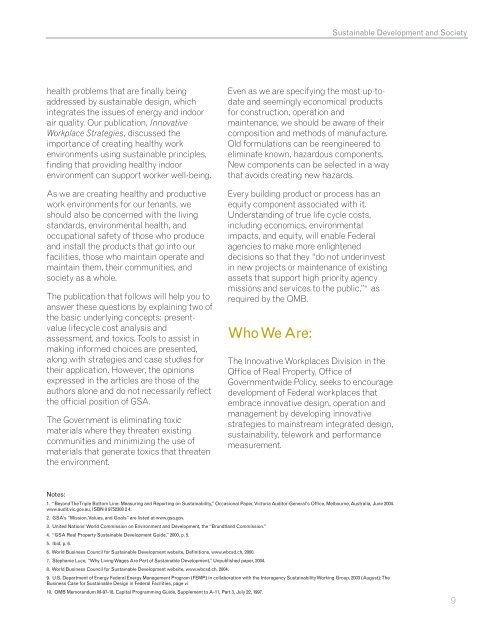Sustainable Development and Society - GSA
Sustainable Development and Society - GSA
Sustainable Development and Society - GSA
You also want an ePaper? Increase the reach of your titles
YUMPU automatically turns print PDFs into web optimized ePapers that Google loves.
<strong>Sustainable</strong> <strong>Development</strong> <strong>and</strong> <strong>Society</strong><br />
health problems that are finally being<br />
addressed by sustainable design, which<br />
integrates the issues of energy <strong>and</strong> indoor<br />
air quality. Our publication, Innovative<br />
Workplace Strategies, discussed the<br />
importance of creating healthy work<br />
environments using sustainable principles,<br />
finding that providing healthy indoor<br />
environment can support worker well-being.<br />
As we are creating healthy <strong>and</strong> productive<br />
work environments for our tenants, we<br />
should also be concerned with the living<br />
st<strong>and</strong>ards, environmental health, <strong>and</strong><br />
occupational safety of those who produce<br />
<strong>and</strong> install the products that go into our<br />
facilities, those who maintain operate <strong>and</strong><br />
maintain them, their communities, <strong>and</strong><br />
society as a whole.<br />
The publication that follows will help you to<br />
answer these questions by explaining two of<br />
the basic underlying concepts: presentvalue<br />
lifecycle cost analysis <strong>and</strong><br />
assessment, <strong>and</strong> toxics. Tools to assist in<br />
making informed choices are presented,<br />
along with strategies <strong>and</strong> case studies for<br />
their application. However, the opinions<br />
expressed in the articles are those of the<br />
authors alone <strong>and</strong> do not necessarily reflect<br />
the official position of <strong>GSA</strong>.<br />
The Government is eliminating toxic<br />
materials where they threaten existing<br />
communities <strong>and</strong> minimizing the use of<br />
materials that generate toxics that threaten<br />
the environment.<br />
Even as we are specifying the most up-todate<br />
<strong>and</strong> seemingly economical products<br />
for construction, operation <strong>and</strong><br />
maintenance, we should be aware of their<br />
composition <strong>and</strong> methods of manufacture.<br />
Old formulations can be reengineered to<br />
eliminate known, hazardous components.<br />
New components can be selected in a way<br />
that avoids creating new hazards.<br />
Every building product or process has an<br />
equity component associated with it.<br />
Underst<strong>and</strong>ing of true life cycle costs,<br />
including economics, environmental<br />
impacts, <strong>and</strong> equity, will enable Federal<br />
agencies to make more enlightened<br />
decisions so that they “do not underinvest<br />
in new projects or maintenance of existing<br />
assets that support high priority agency<br />
missions <strong>and</strong> services to the public,” 9 as<br />
required by the OMB.<br />
Who We Are:<br />
The Innovative Workplaces Division in the<br />
Office of Real Property, Office of<br />
Governmentwide Policy, seeks to encourage<br />
development of Federal workplaces that<br />
embrace innovative design, operation <strong>and</strong><br />
management by developing innovative<br />
strategies to mainstream integrated design,<br />
sustainability, telework <strong>and</strong> performance<br />
measurement.<br />
Notes:<br />
1. “Beyond The Triple Bottom Line: Measuring <strong>and</strong> Reporting on Sustainability,” Occasional Paper, Victoria Auditor-General's Office, Melbourne, Australia, June 2004.<br />
www.audit.vic.gov.au, ISBN 0 9752308 2 4.<br />
2. <strong>GSA</strong>’s “Mission, Values, <strong>and</strong> Goals” are listed at www.gsa.gov.<br />
3. United Nations’ World Commission on Environment <strong>and</strong> <strong>Development</strong>, the “Brundtl<strong>and</strong> Commission.”<br />
4. “<strong>GSA</strong> Real Property <strong>Sustainable</strong> <strong>Development</strong> Guide,” 2000, p. 5.<br />
5. Ibid, p. 6.<br />
6. World Business Council for <strong>Sustainable</strong> <strong>Development</strong> website, Definitions, www.wbcsd.ch, 2000.<br />
7. Stephanie Luce, “Why Living Wages Are Part of <strong>Sustainable</strong> <strong>Development</strong>,” Unpublished paper, 2004.<br />
8. World Business Council for <strong>Sustainable</strong> <strong>Development</strong> website, www.wbcsd.ch. 2004.<br />
9. U.S. Department of Energy Federal Energy Management Program (FEMP) in collaboration with the Interagency Sustainability Working Group, 2003 (August): The<br />
Business Case for <strong>Sustainable</strong> Design in Federal Facilities, page vi<br />
10. OMB Memor<strong>and</strong>um M-97-18, Capital Programming Guide, Supplement to A-11, Part 3, July 22, 1997.<br />
9

















